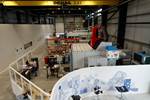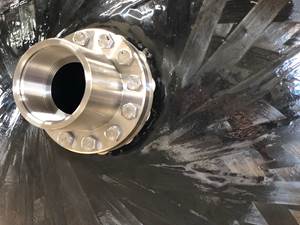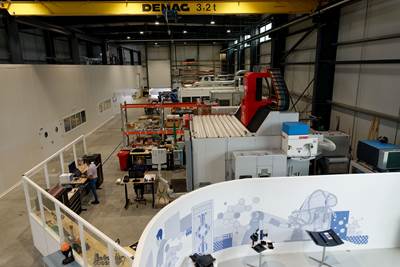From the Publisher - 6/1/2007
Salt Lake City, Utah has established itself as an area of expertise in composites manufacturing and the SME Composites Manufacturing Conference held there in April made it pay off. Not only did the meeting have outstanding technical and business participation from local companies but it also drew presenters from major
Salt Lake City, Utah has established itself as an area of expertise in composites manufacturing and the SME Composites Manufacturing Conference held there in April made it pay off. Not only did the meeting have outstanding technical and business participation from local companies but it also drew presenters from major composite aircraft manufacturers from around the country: ATK, Bell Helicopter, Northrop Grumman, Lockheed Martin, Boeing Commercial Airplanes and Adam Aircraft were all present. Needless to say, this event was focused on aircraft manufacturing, with an emphasis on automated processing. But that emphasis has implications for CT readers.
The big automated placement machine manufacturers, Cincinnati Machine, Ingersoll Machine, Forest Liné and MTorres were there, pointing out the special capabilities of their specific technologies. Both ATK and Accudyne discussed application-specific machinery (designed to build a single part at optimum speed and highest quality) that has the potential to bring down costs and increase throughput for high-volume part production in applications like aircraft stringers. Thursday keynote speaker Mike Blair, the VP of business development and marketing for ATK Space Systems, discussed the business case for companies investing in expensive automated equipment, and he suggested that standardized materials, lower tooling costs and out-of-autoclave methods were needed to make a step change in the cost of aerospace parts. These suggestions, along with the volume production methods being perfected for aircraft, could be useful in other markets that want and need to use composite materials. And technology transfer is getting faster all the time.
Three of the features in this issue cover industries that have high volume/low cost requirements. Energy harvest, in the form of offshore oil production and the development of both wind turbines and marine current turbines for generating electrical energy from wind and seawater represent applications that are already taking off and have immense future growth potential. Our “Deepwater Oil Exploration” article (see “Related Content,” at left) looks at composite umbilical and riser pipe that is strong enough to carry deepwater loads, flexible enough to handle differing catenary scenarios, lightweight enough to reduce structural demands and also resistant to the corrosive effects of saltwater. Lightweight composite structures are being used for fire suppression systems on offshore platforms. These materials keep people and equipment safe under huge thermal loads.
Generating energy from tides and deepwater currents is a technology that is getting serious consideration around the world. Less intrusive than wind blades, it also may offer a more consistent and predictable renewal energy source. Tidal turbine design and siting will be key, and they will need to be made of composite materials. (Click on “Tidal Turbines ….” under “Related Content,” at left.)
It’s been obvious for years that the automotive industry would like to use more composite materials, and increasing environmental pressures make their use more attractive than ever. Tesla Motors has come up with an electric car that will go from 0 to 60 in four seconds, has a top speed of 130 mph and runs more than 200 miles on a charge. OK, it costs $100,000, but that’s not much more than a high-end Mercedes, BMW or Jaguar. See “Engineering Insights” under “Related Content”.
Composites solve many of the materials issues discussed. Continued processing improvements will solve even more, and the solutions are coming faster.
Related Content
Infinite Composites: Type V tanks for space, hydrogen, automotive and more
After a decade of proving its linerless, weight-saving composite tanks with NASA and more than 30 aerospace companies, this CryoSphere pioneer is scaling for growth in commercial space and sustainable transportation on Earth.
Read MoreHigh-tension, vertical filament winding enables affordable flywheel energy storage system
French startup Energiestro’s prototype solar energy flywheel-based storage system aims to reduce costs with glass fiber composites and prestressed concrete.
Read MorePolar Technology develops innovative solutions for hydrogen storage
Conformable “Hydrogen in a Box” prototype for compressed gas storage has been tested to 350 and 700 bar, liquid hydrogen storage is being evaluated.
Read MoreAchieving composites innovation through collaboration
Stephen Heinz, vice president of R&I for Syensqo delivered an inspirational keynote at SAMPE 2024, highlighting the significant role of composite materials in emerging technologies and encouraging broader collaboration within the manufacturing community.
Read MoreRead Next
“Structured air” TPS safeguards composite structures
Powered by an 85% air/15% pure polyimide aerogel, Blueshift’s novel material system protects structures during transient thermal events from -200°C to beyond 2400°C for rockets, battery boxes and more.
Read MorePlant tour: Daher Shap’in TechCenter and composites production plant, Saint-Aignan-de-Grandlieu, France
Co-located R&D and production advance OOA thermosets, thermoplastics, welding, recycling and digital technologies for faster processing and certification of lighter, more sustainable composites.
Read MoreAll-recycled, needle-punched nonwoven CFRP slashes carbon footprint of Formula 2 seat
Dallara and Tenowo collaborate to produce a race-ready Formula 2 seat using recycled carbon fiber, reducing CO2 emissions by 97.5% compared to virgin materials.
Read More









